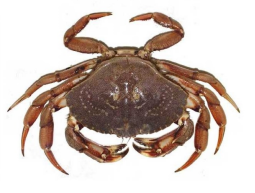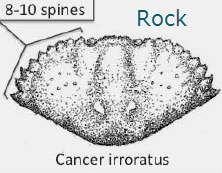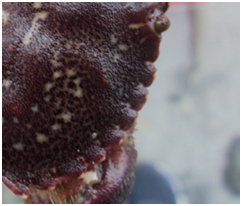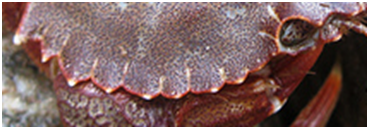|
Rock and Jonah crabs
|
|
Crabs
Crabs
Blue Crab
Blue Crab
Molting
Fiddler Crabs
Rock Crabs
Peekytoe
Jonah
Crab
Rock vs
Jonah
Crabs |
|
Rock Crab / Jonah Crab
- similarities and differences |
|

Two species:
Cancer
irroratus - Atlantic Rock Crab
Cancer
borealis - Jonah Crab
Often misidentified
They are similar in appearance and habitat but there
are some differences: |
|
Jonah (Cancer borealis)
and Atlantic rock crabs (Cancer irroratus) have
essentially been bycatch in the American lobster
fishery for more than 80 years |
|
Jonah
crabs are larger than Atlantic rock crabs and
they are more commonly found at depths of
165 feet to 1000 feet
(50–300 m) and up to 2,600 feet (800 m)
Rock crabs are smaller and
prefer shallower, inshore waters ranging
from 20 to 1500 feet (6-456 m) and are most
often found at depths less than 65 feet (20 m) |
|
Size:
Jonah crab size:
males up to 7 inches (175mm) and females up to 6
inches (152mm)
Rock crab size:
males up to 6.5 inches (140mm) and females up to
4 inches (100mm)
Size is not always a good method of
identification as mature rock rock crab may be
the same size as an immature jonah crab |
|
Size:
chelea (claws)
Jonah crab claws:
large, typically with black tips
Rock crab claws:
not really large - slender |
|
Movement:
Jonah crab :
slow moving, easy to catch.
Rock crab size:
quick, agile. very quick to "bite" |
|
Seasonal Habitat:
Jonah crab: It is widely accepted that
this species moves offshore in the fall
and winter, and females have been documented
moving inshore in late spring and summer.
Rock crab: Each season this species
moves between varying depths. In the autumn,
which is their season of reproduction, most rock
crabs remain at shallow depths
They tend to bury
themselves in rocky areas, in tide pools and
wander into lagoons. |
|
Physical difference:
Both the Jonah crab
and the Rock crab have oval carapaces (shells)
but...
The Jonah Crab’s carapace
has a more rounded, dome-like surface with
jagged marginal spines *.
The Rock Crab’s carapace
is flatter and flares out at the sides, and its
spines come to a single point
*
marginal spines run from
either eye along the side of the carapace (see
images below




|
|
|
|
|
|
|
